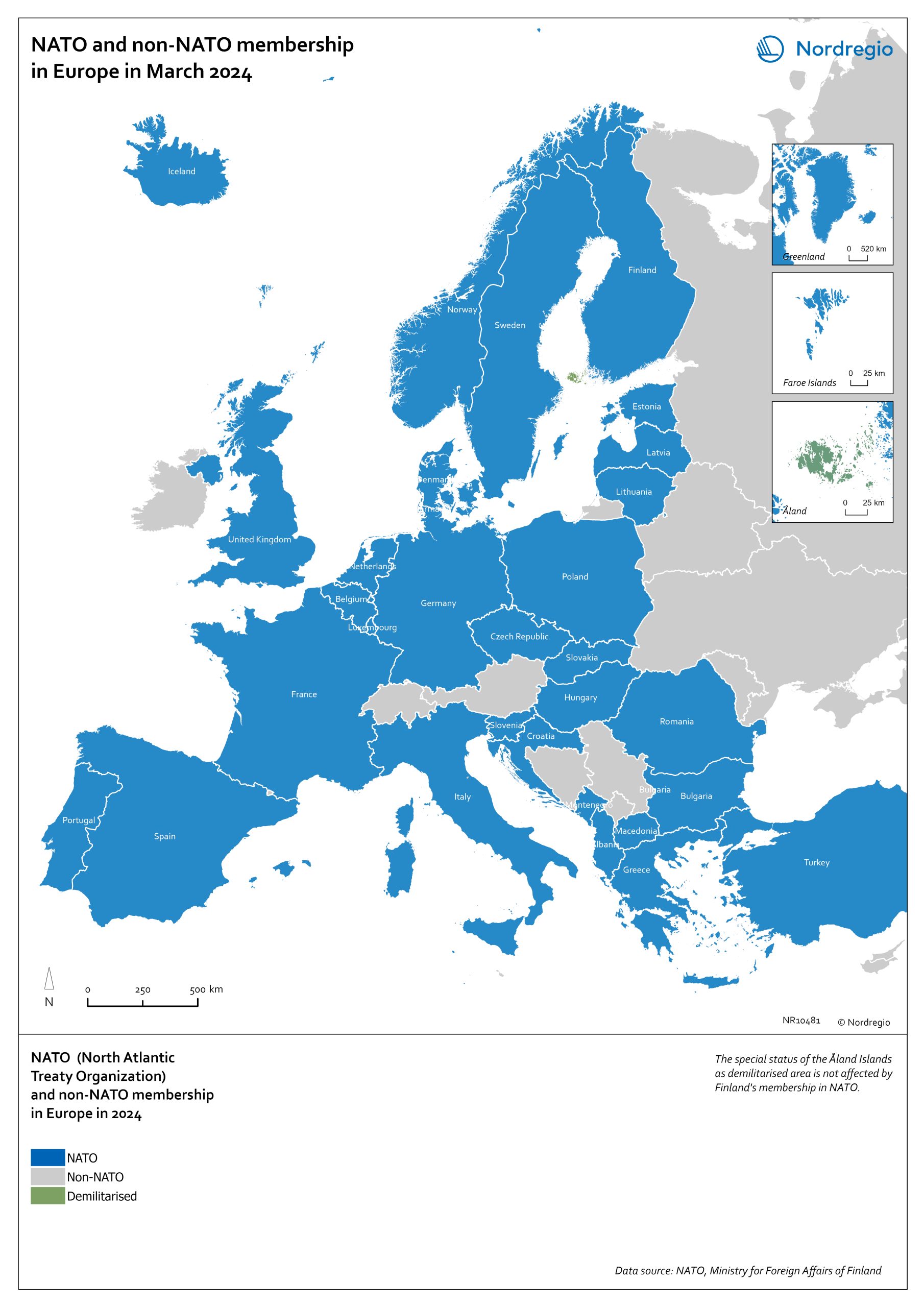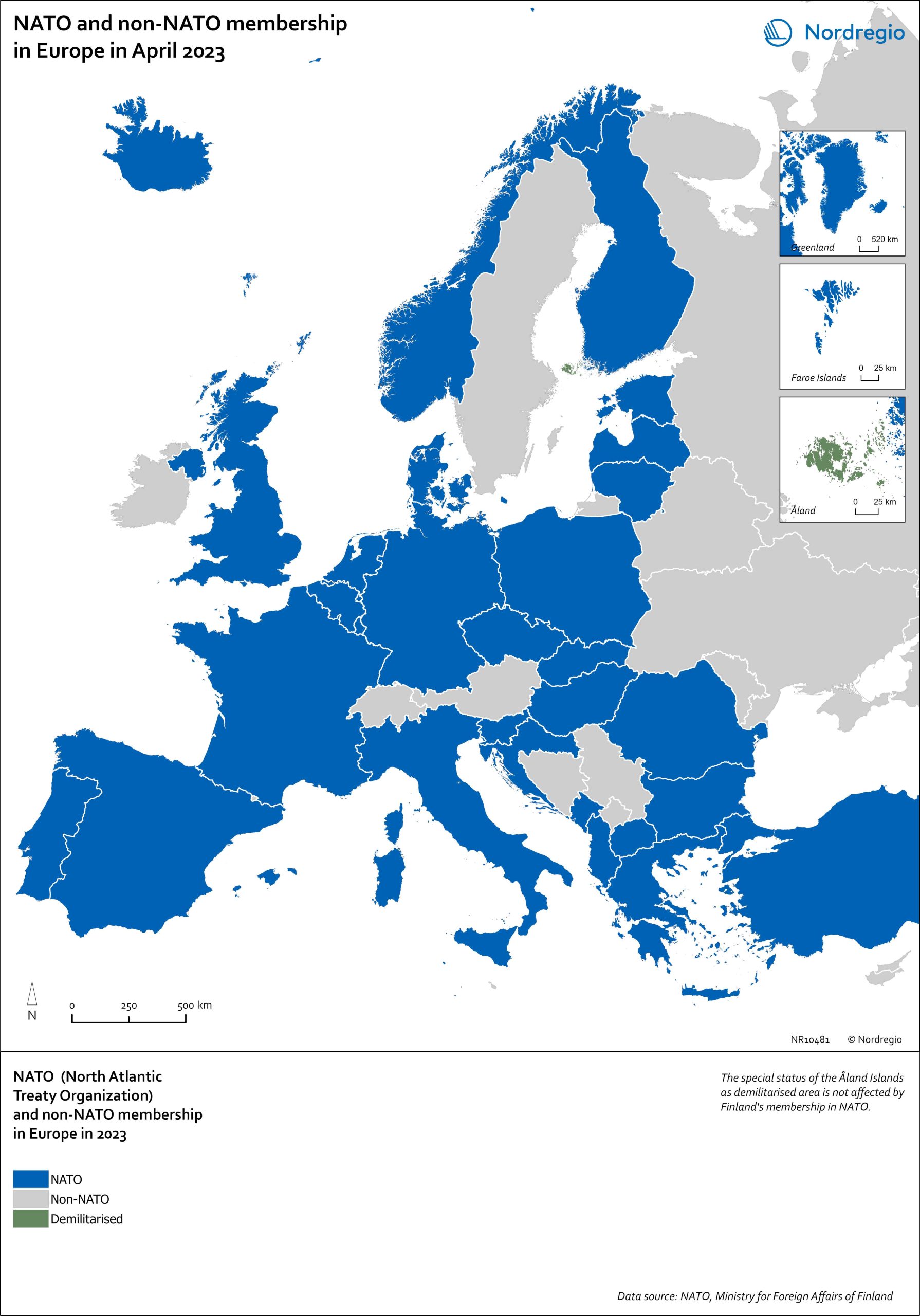41 Maps
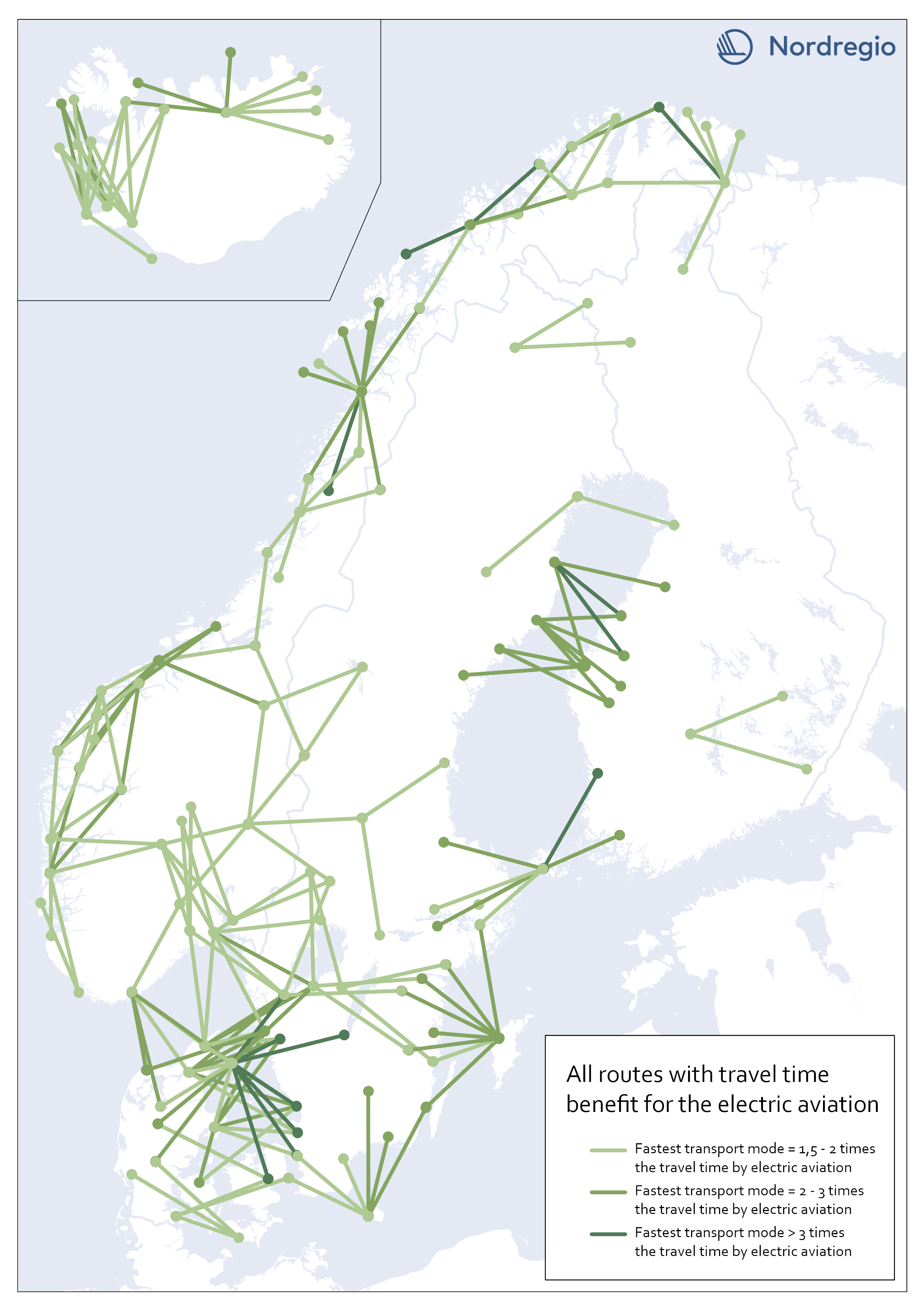
All routes with time benefit for electric aviation
The map shows all routes in our sample with significant travel time benefit for electric aviation. They are 203 in total. A route has a significant travel time benefit if the travel time for both car and public transportation exceeded 1,5 times the travel time for electric aviation. I.e., if one of the existing transport modes is faster or up to 1,5 times the travel time for electric aviation, electric aviation does not have the potential to improve accessibility between the two destinations, according to our analysis.
2023 February
- Nordic Region
- Transport
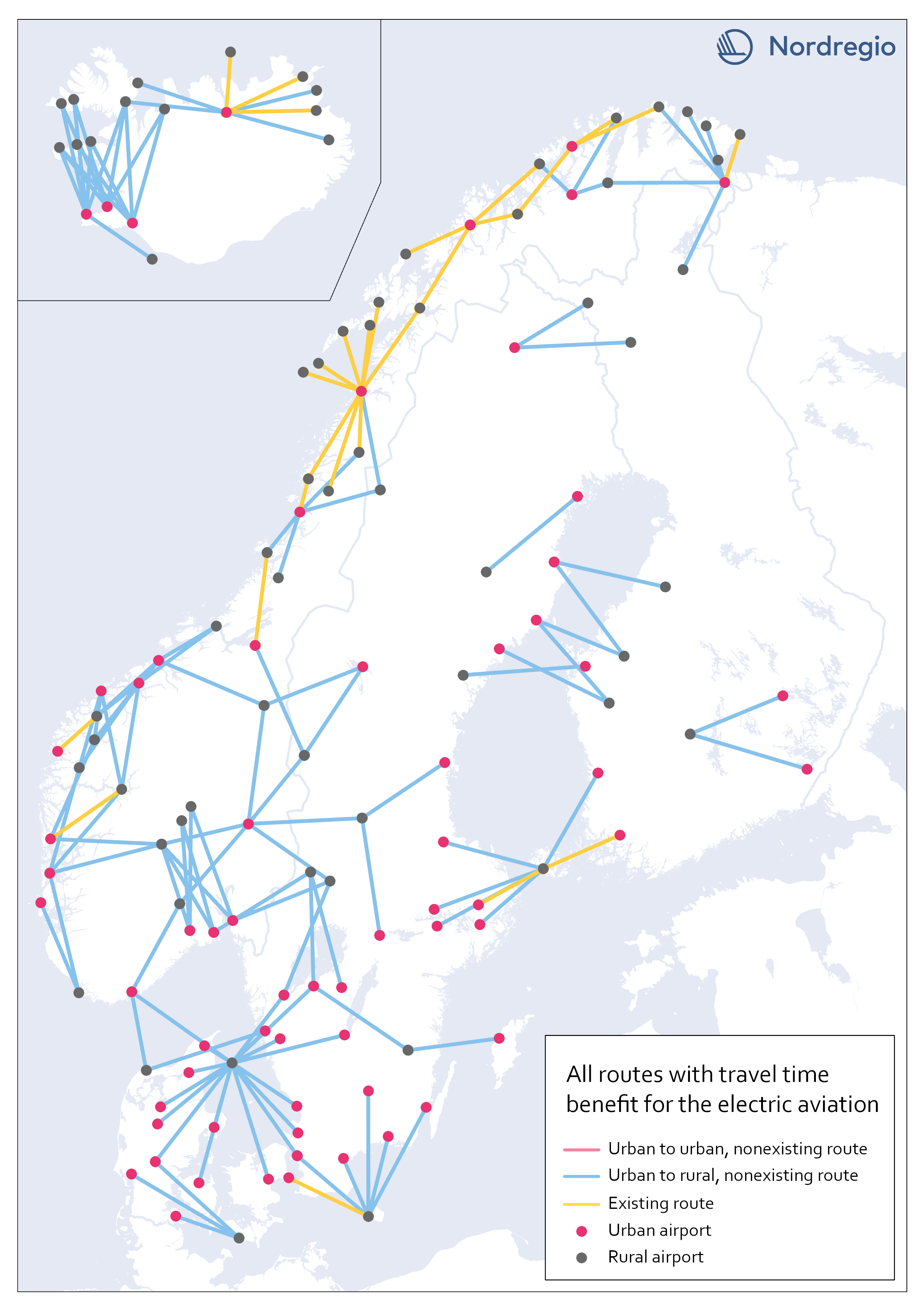
Electric aviation time benefits between urban and rural areas
The map shows all routes between urban and rural areas where electric aviation has significant time benefits compared to other traffic modes. Yellow lines are already served by aviation, while blue color indicates non-existent routes where electric flight would reduce the travel time between destinations. Our motivation for focusing on urban-rural routes was based on the assumption that electric aviation can increase the access for rural areas to public facilities and job opportunities, as well as the possibility of connecting remote areas with national and international transport systems. The result, though, can only be understood in terms of travel time benefits between the areas, and thus reveals little about accessibility to mentioned opportunities. The following are examples of themes to be investigated further within the main project. Identify regional hubs Among others, the project FAIR (2022) has addressed the need to update the flight system to a more flexible aviation network, that meet travelers’ needs with smart mobility. This can be done by identifying demands and establishing regional hubs for electric aviation, which can serve remote and regional areas. The potential of Hamar and Bodö in Norway as regional hubs should be studied more closely.
2023 January
- Nordic Region
- Transport
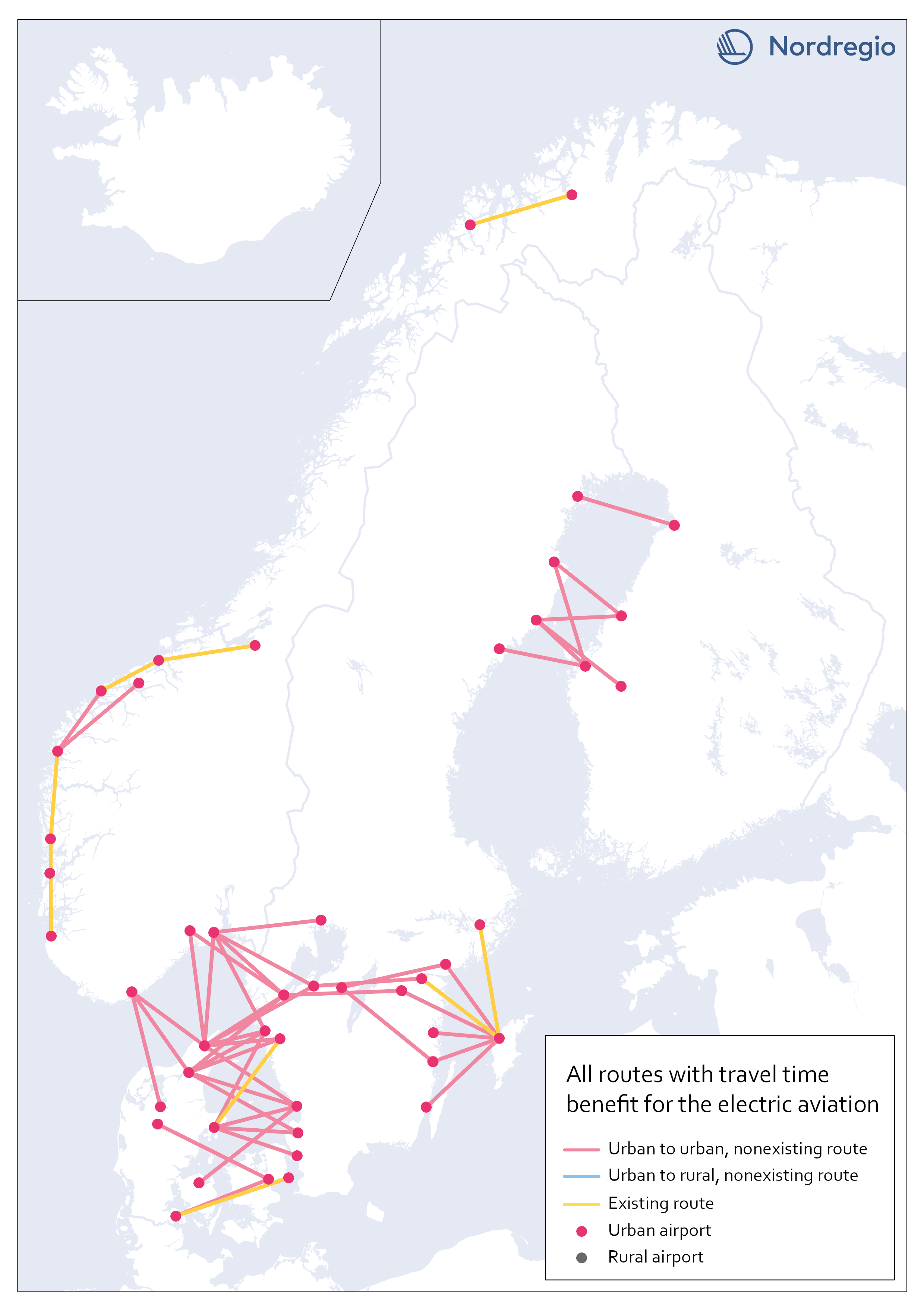
Electric aviation time benefits between urban areas separated by water
The map shows all routes between urban areas separated by water, and where electric aviation has significant time benefits compared to the fastest traffic mode. Yellow lines are already served by aviation, while red color indicates non-existent routes where electric flight would reduce the travel time between destinations. The result is in line with our assumptions, that there is a lack of fast connections between potential labor markets in urban areas, which are geographically close but separated by open water.
2023 January
- Nordic Region
- Transport
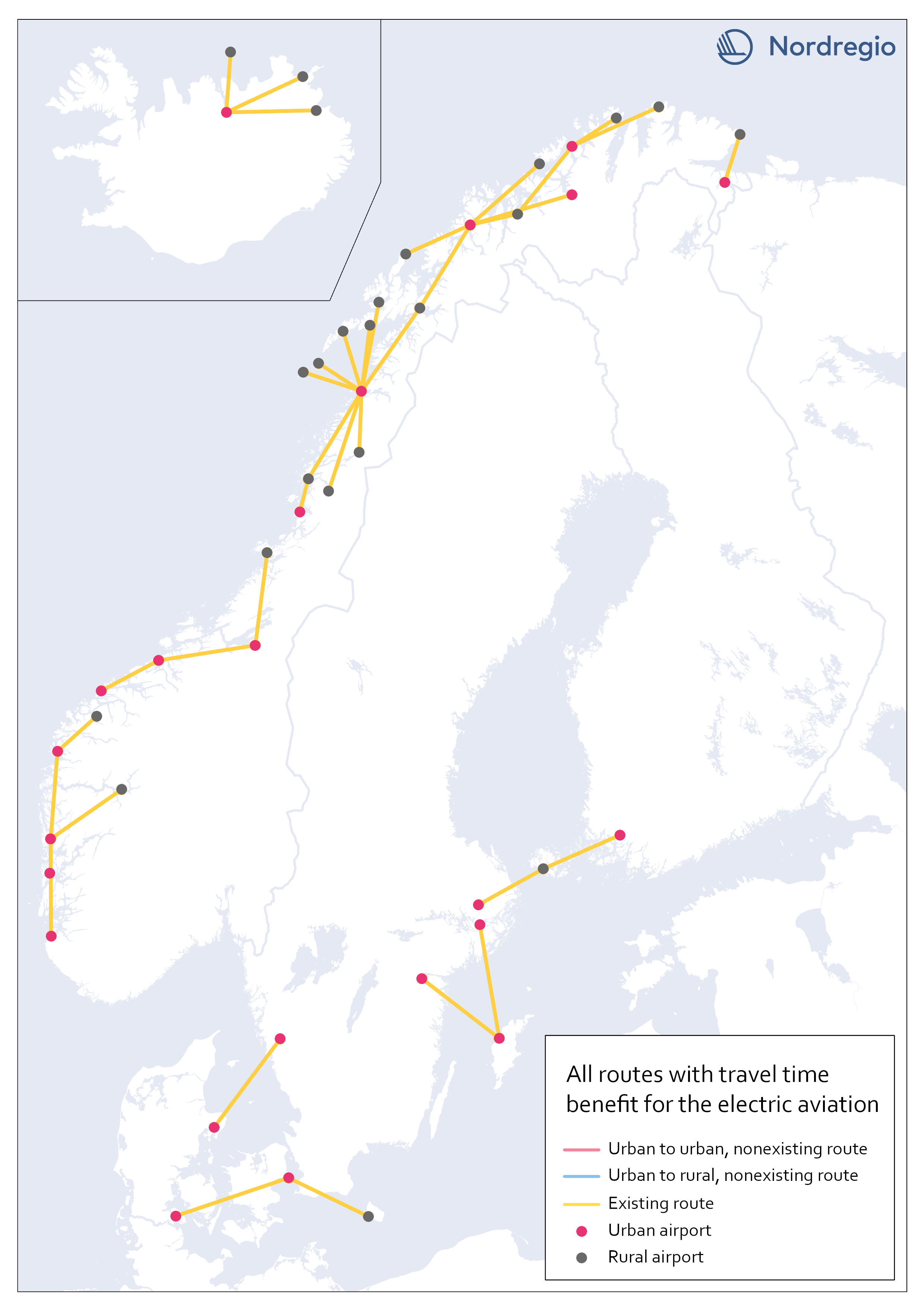
Existing routes with time benefit for electric aviation
The map visualizes all routes with significant travel time benefit, which are already served with commercial flights. Information on existing routes has been obtained from the report Nordic Sustainable Aviation (Ydersbond et al, 2020) and applies to the year 2019. Since then, routes may have been added or removed, which is important to bear in mind in future investigations. However, choosing a later year risk giving equally misleading results, as flights decreased drastically during the pandemic. Statistics for 2019 provide a picture of the demand that existed before the pandemic, which is the latest stable levels that can be obtained. Whether air traffic will ever return to the same levels as before the pandemic is too early to say. The majority of routes are found in Norway, along the coastline, which confirms earlier knowledge that Norway has a more extensive and coherent aviation network than the rest of the Nordic region.
2023 January
- Nordic Region
- Transport
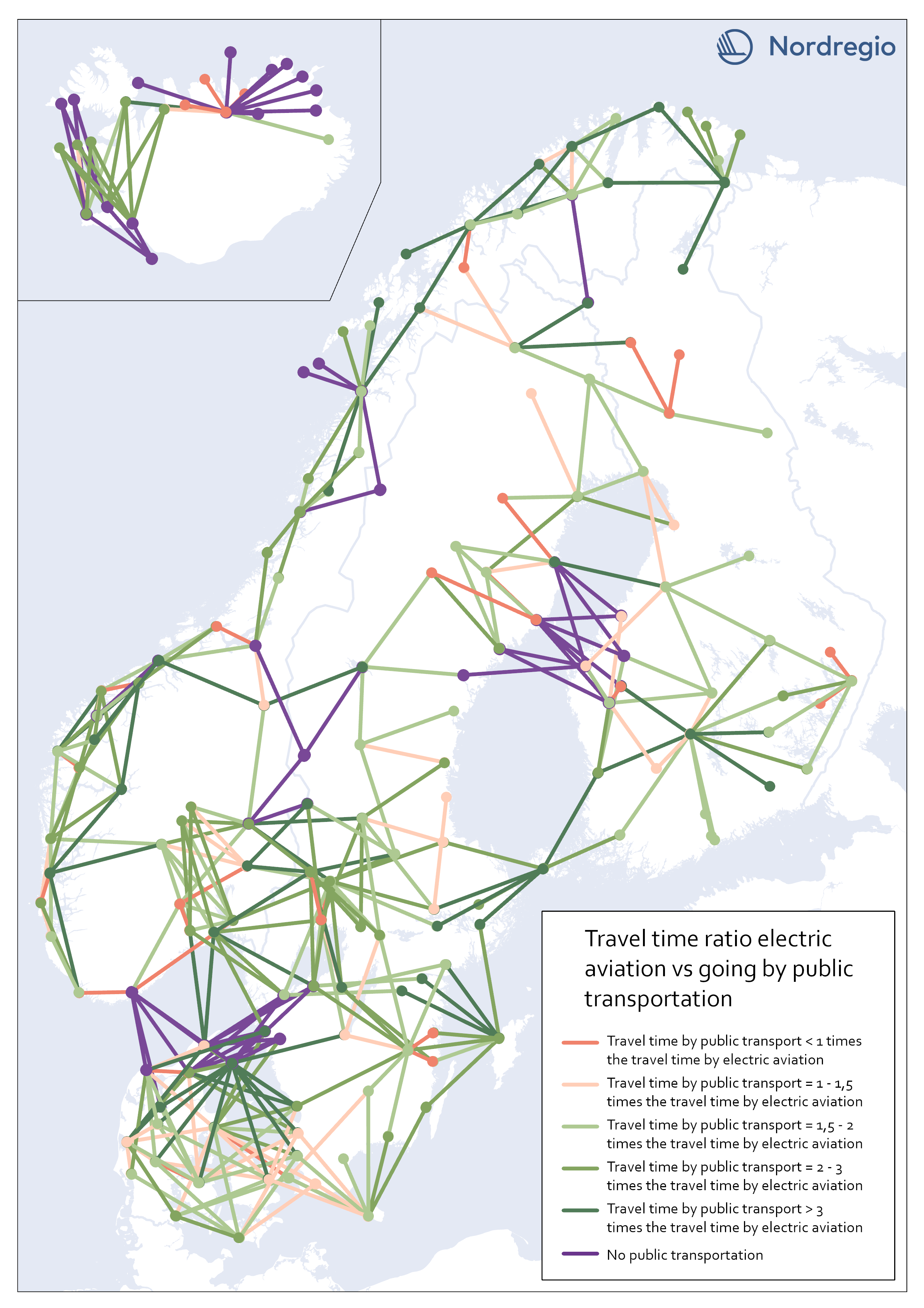
Travel time ratio – electric aviation vs public transportation
This map shows the travel time calculations for electric aviation versus travelling by public transportation. Routes represented by any nuance of green, are routes with significant travel time benefits for electric aviation in comparison with public transportation. The darker the nuance of green, the larger time benefit for electric aviation. The beige color represents routes where the travel time for public transportation is the same or up to 1,5 times the travel time for electric aviation. The red color represents routes where public transportation is faster than electric aviation. Purple lines represent routes where no public transportation is available. These were also routes where we could see significant time benefits for electric aviation. The number of changes when commuting with public transport may have a negative impact on perceived accessibility. In this accessibility analysis, however, we stay with the same criteria for public transport as for travel by car. For future research, the number of changes when commuting by public transport could be considered in the comparison.
2023 January
- Nordic Region
- Transport
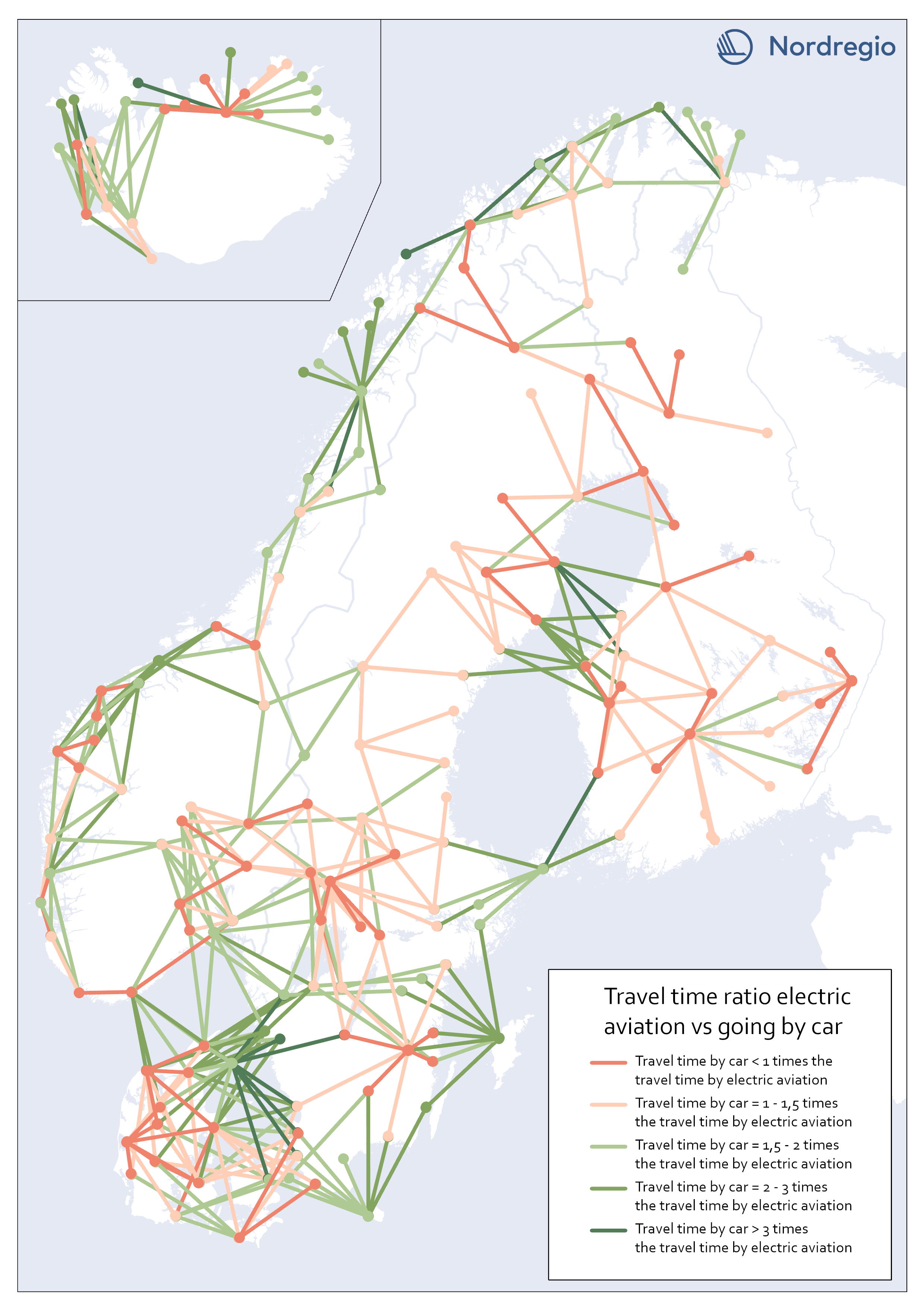
Travel time ratio – electric aviation vs car
This map shows the travel time calculations for electric aviation versus traveling by car. Routes represented by any nuance of green, are routes with significant travel time benefits for electric aviation in comparison with car. The darker the nuance of green, the larger time benefit for electric aviation. The beige color represents routes where the travel time for car is the same or up to 1,5 times the travel time for electric aviation. The red color represents routes where car is faster than electric aviation.
2023 January
- Nordic Region
- Transport
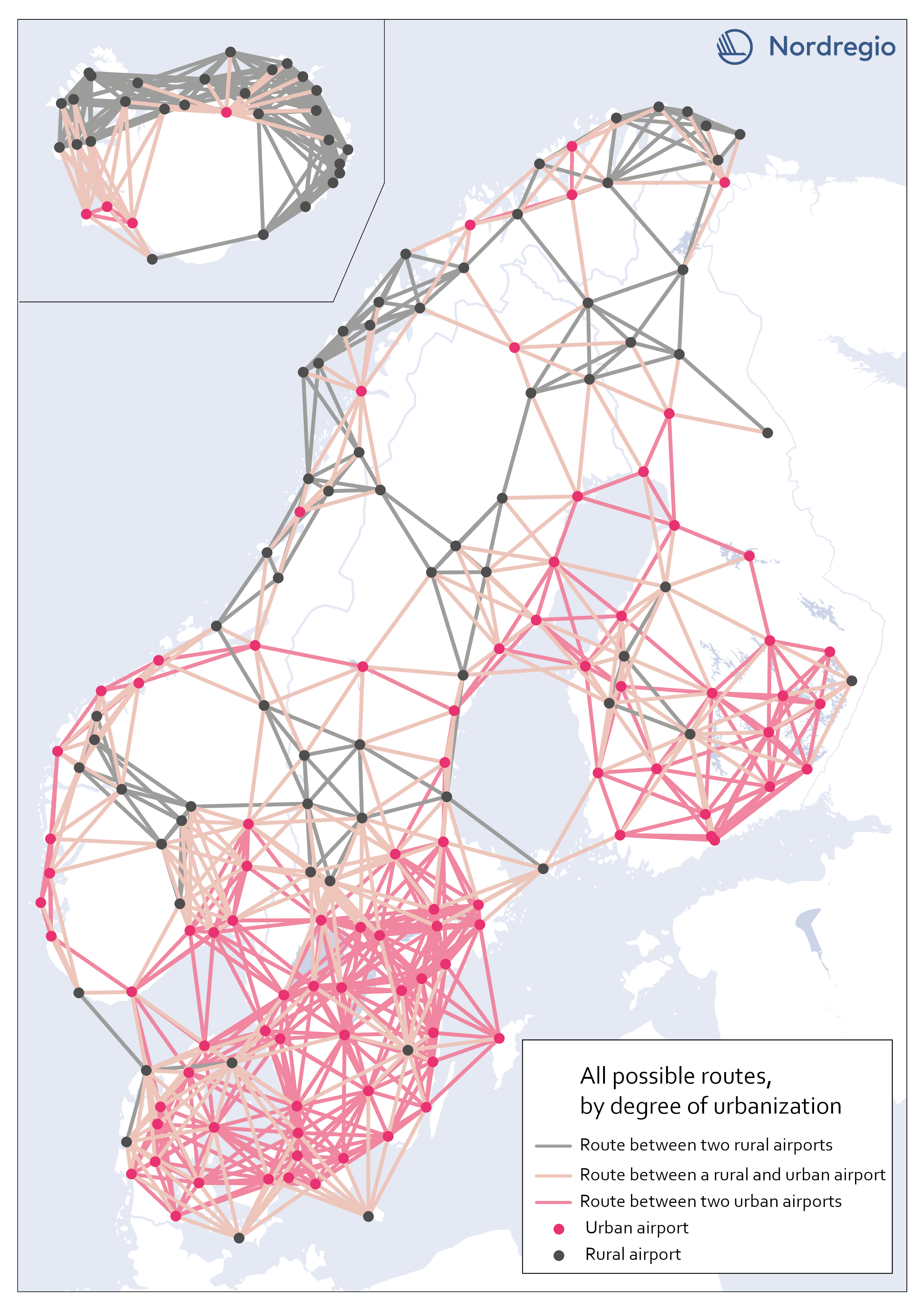
All possible electric aviation routes by a degree of urbanisation
The map shows all routes with a maximum distance of 200 km divided into three categories, based on the airports’ degree of urbanization: Routes between two rural airports, routes between one rural and one urban airport and routes between two urban airports. The classification is based on the new urban-rural typology. We restricted the analysis to routes between rural and urban areas as well as routes between urban areas that are separated by water. Those are 426 in total. We based our criteria on the assumption that accessibility gains to public services and job clusters can be made for rural areas, if better connected to areas with a high degree of urbanization. Because of possible potential to link labor markets between urban areas on opposite sides of water urban to urban areas that cross water are also included. This is based on previous research which has shown the potential for electric aviation to connect important labor markets which are separated by water, particularly in the Kvarken area (Fair, 2022). Our choice of selection criteria means that we intentionally ignore routes where electric aviation may have a potential to reduce travel times significantly. There might also be other important reasons for the implementation of electric aviation between the excluded routes. Between rural areas, for example, tourism or establishing a comprehensive transport system in the Nordic region, constitute reasons for implementing electric aviation. Regarding routes between urban areas over mainland, the inclusion of more routes with the same rationale as above – that significant time travel benefits could be gained between labor markets with electric aviation (for example between two urban areas in mountainous regions where travel times can be long) – can be motivated. Some of those routes can be important to investigate at a later stage but are outside the…
2023 January
- Nordic Region
- Transport
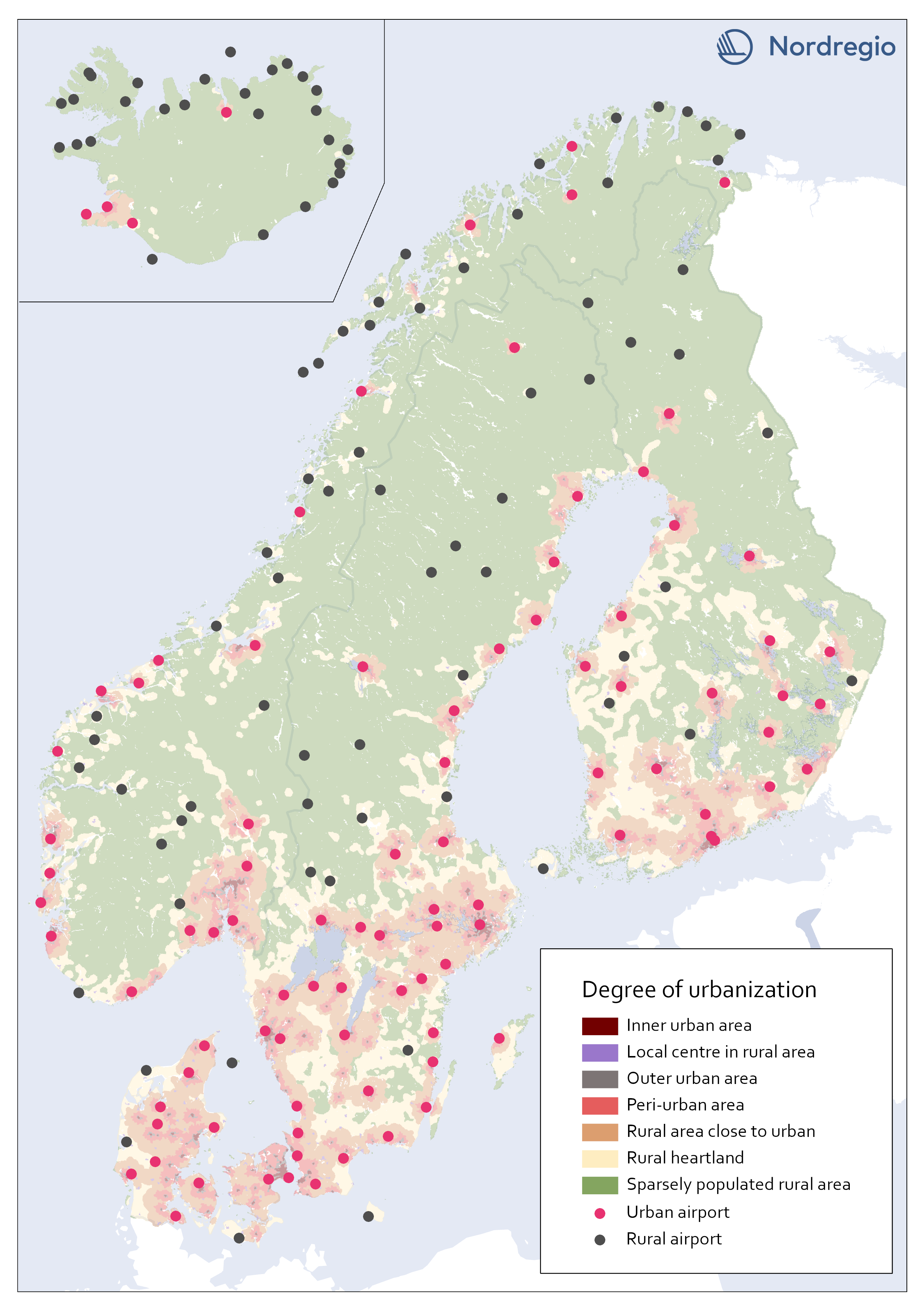
All airports in the Nordic region by a degree of urbanisation
This map classifies all airports by a degree of urbanisation. The classification is based on the new urban-rural typology. We classified all airports localized within any of the top five urbanization classes (Inner urban area, Local center in rural area, Outer urban area, peri-urban area, or Rural area close to close to urban) as Urban. All other airports, localized within the bottom two classes (Rural heartland or Sparsely populated rural area) were classified as Rural. No adjustments were made based on the proximity of the airports to urban areas. During the process we considered adjustments in the categorization based on the airports’ potential catchment area from a close urban area. For example, one can assume that Gällivare Lappland airport in the north of Sweden, has its main catchment area from Gällivare which is classified as a local center in rural area (i.e. Urban). The airport, though, is localized within the category Rural heartland. Yet, we decided to let the typology determine to which category each airport belong.
2023 January
- Nordic Region
- Transport
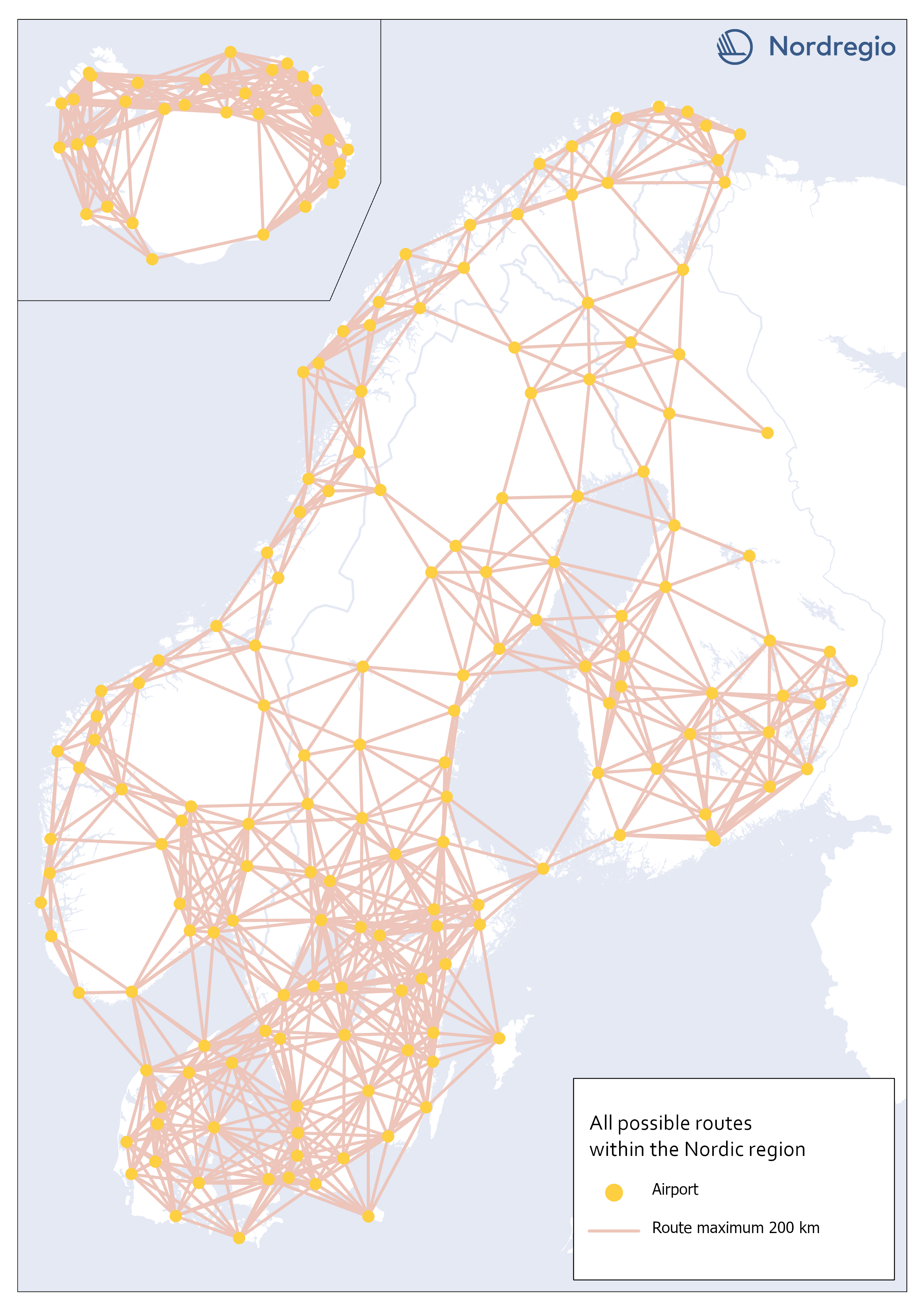
All possible electric aviation routes, max 200km, within the Nordic region
This map shows all possible electric aviation routes of a maximum distance of 200 kilometres within the Nordic region. First generation electric aviation will have a limited range due to battery capacity. According to the report Nordic Sustainable Aviation, routes up to 400 kilometers constitute an initial market for electric airplanes in the Nordic region. However, also shorter distance routes under 200 km, where cruise speed is less important and in sparsely populated regions where passenger volumes are very small, will be the focus (Ydersbond et al, 2020). The first generation of aircrafts that rely solely on electric power have a defined maximum range of 200 km (Heart Areospace, 2022). For this accessibility study, we only included routes of a maximum distance of 200 kilometers. This selection gave us 1001 possible routes in total.
2023 January
- Nordic Region
- Transport
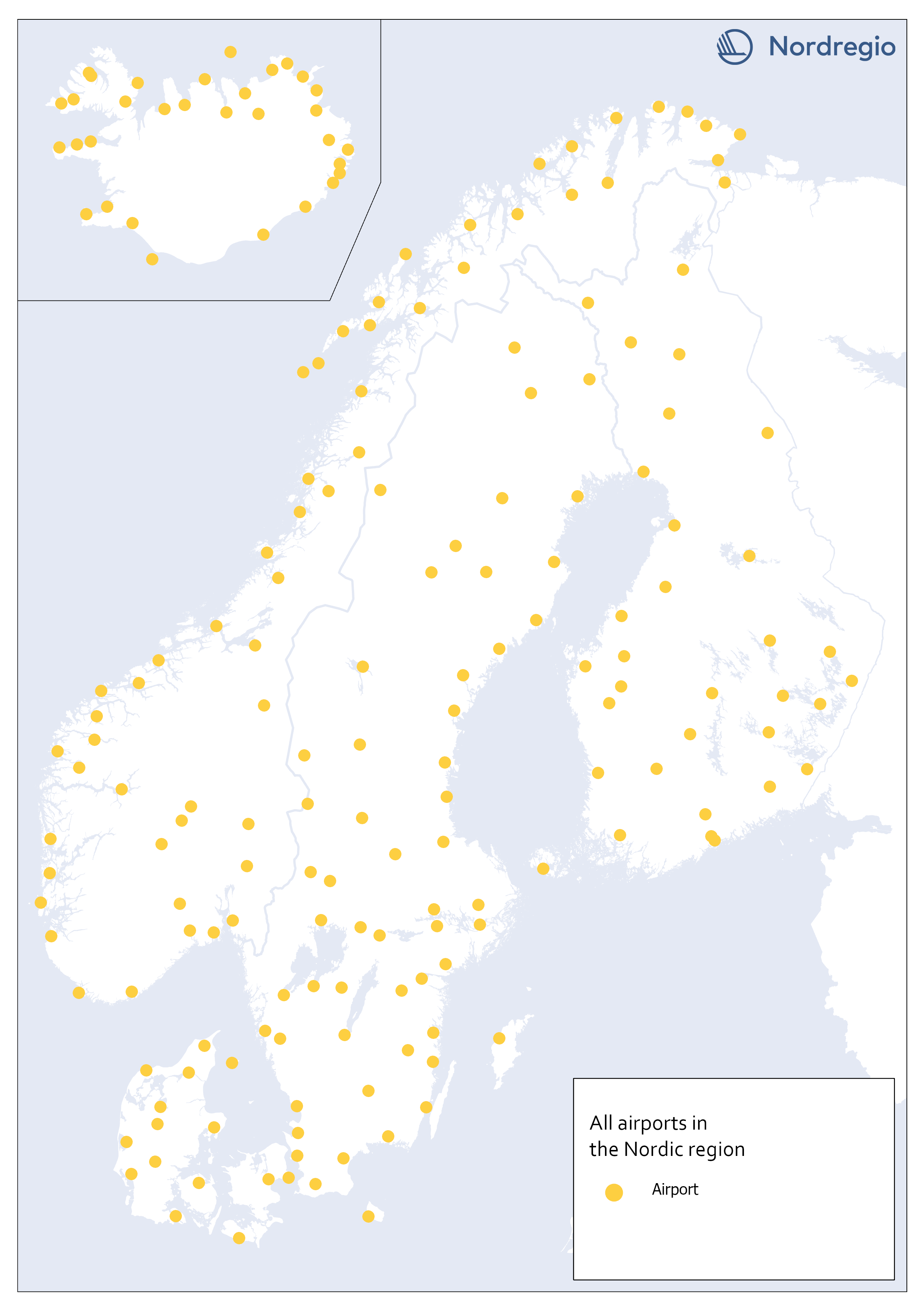
All airports in the Nordic region
This map shows all airports within the geographical scope which may be operated with commercial flight. To limit our selection of airports, we used a combination of two official airport code systems: IATA (International Air Transport Association) and ICAO (International Civil Aviation Organization). IATA-codes specify the airport as a part of a commercial flight route. However, the IATA system, is not solely limited to airports. Other locations, such as bus or ferry stations can also apply for an IATA location code, as long it is included in an airline travel chain. The ICAO-code, on the other hand, indicates that the location is an airport, but not necessarily for commercial flights In order to obtain a selection of airports that met our criteria, an airport was included only if it had both an IATA-code and an ICAO-code. Three different sources are used: 1) Swedavia (lists all airports in the Nordics that Swedavia traffics today). This is our main source, but it does not include all existing airports in the Nordic countries. Therefore, we also use two other sources: 2) Avcodes: Airport code database, from which other airports, that are not served by Swedavia, are obtained. 3) Wikipedia. Finally, the listed airports are checked against Wikipedia, to verify if any airports have been missed through the other sources. This selection gave us 186 airports in total.
2023 January
- Nordic Region
- Transport
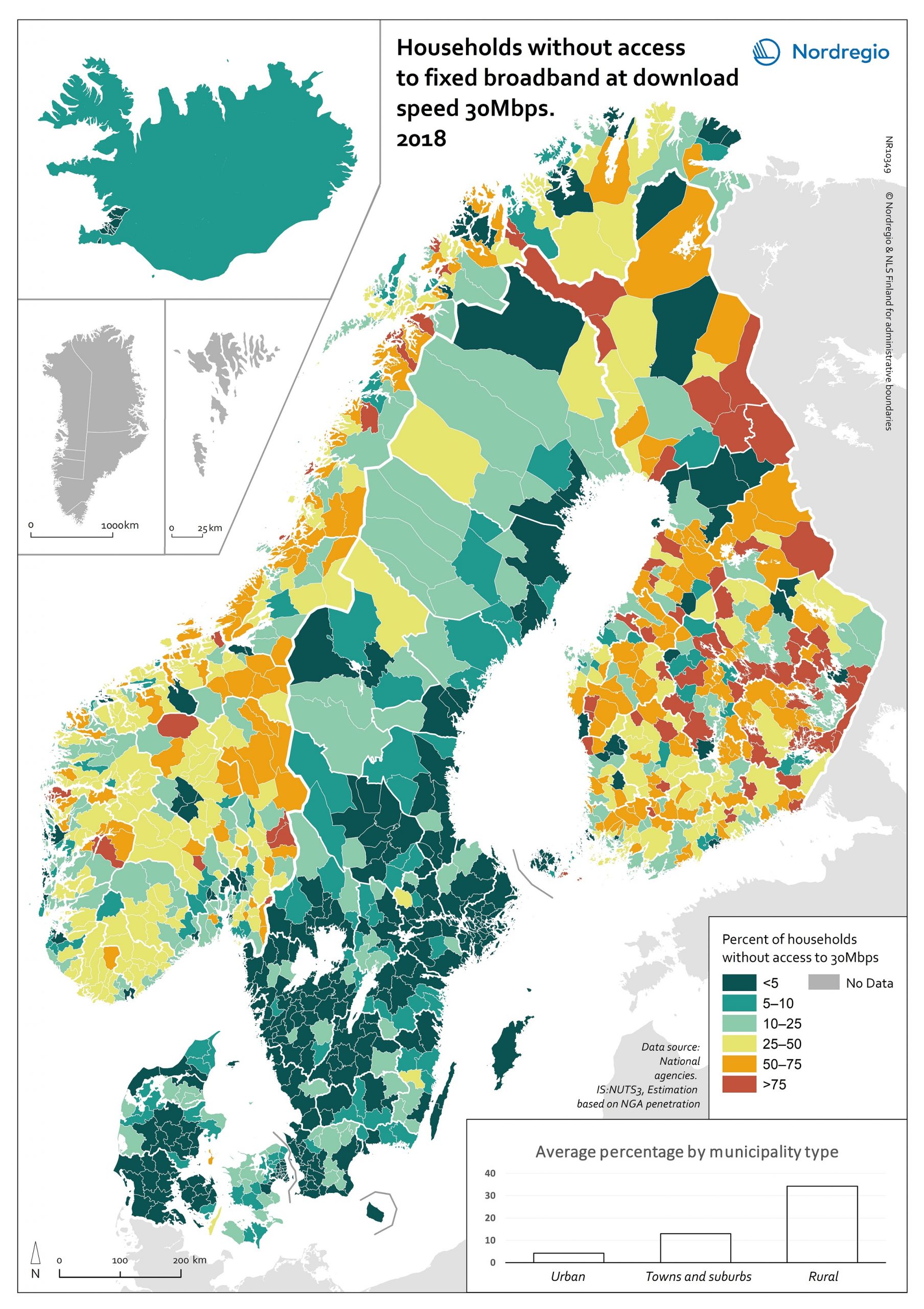
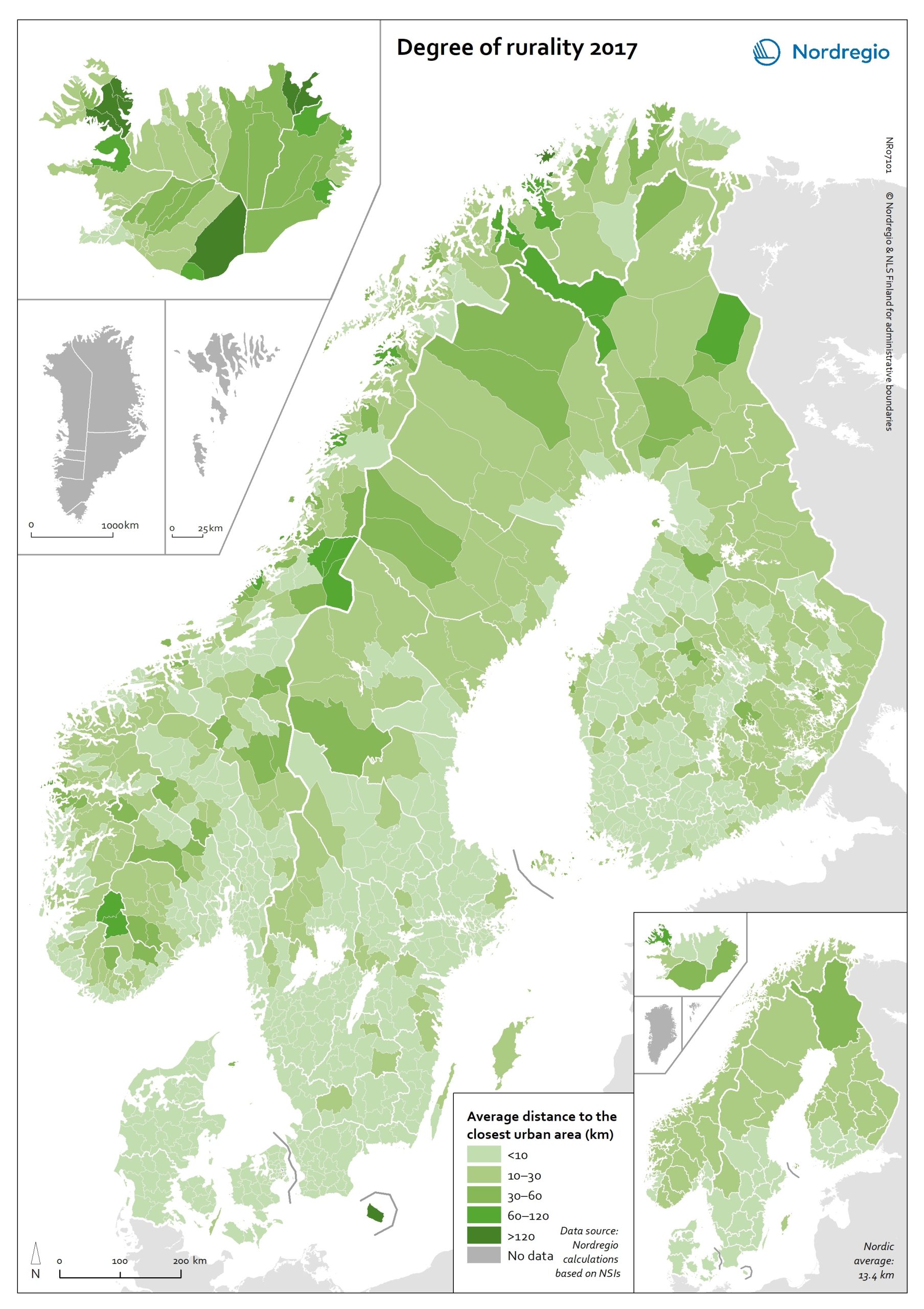
Degree of rurality at the municipal and regional level in 2017
This map shows the average distance to the edge of the closest urban area for the population living outside urban areas in the Nordic municipalities and regions. These figures are of particular interest in the analysis of urban-rural patterns and the Nordic populations’ access to local services in sparsely population areas. The darker shades on the map indicate longer average distances to the edge of the nearest urban area, and the lighter shades indicate shorter average distances. While almost all Danish municipalities have an average distance of below 10 km from rural grid cells to the nearest urban area, a large share of the municipal populations of the remaining Nordic countries need to contend with longer average distances to local services. The largest distances can be found in several municipalities of Iceland and Norway (Árneshreppur 230 km, Hasvik 154 km), whereas the largest average distances for Finnish and Swedish municipalities are considerably shorter (Enontekiö 103 km, Storuman 52 km). Regarding within-country variation, shorter average distances can generally be found in southwestern Finland and southern Sweden, in comparison with the more remote parts of these countries. Both Norway and Iceland provide a rather more mixed picture, since there are municipalities with shorter average distances scattered across different parts of each country. Method used to calculate the degree of rurality In order to take into account access to services such as grocery stores, pharmacies, schools, community centres and public transport, the European definition of urban grid cells was used to create this map, i.e. a population density threshold of 300 inhabitants per km2 applied to grid cells of 1 km2. The closest distance was calculated from each rural grid cell centroid to the nearest urban grid cell centroid along the existing road network traversable by car, including car ferries, based on population…
2020 October
- Environment
- Nordic Region
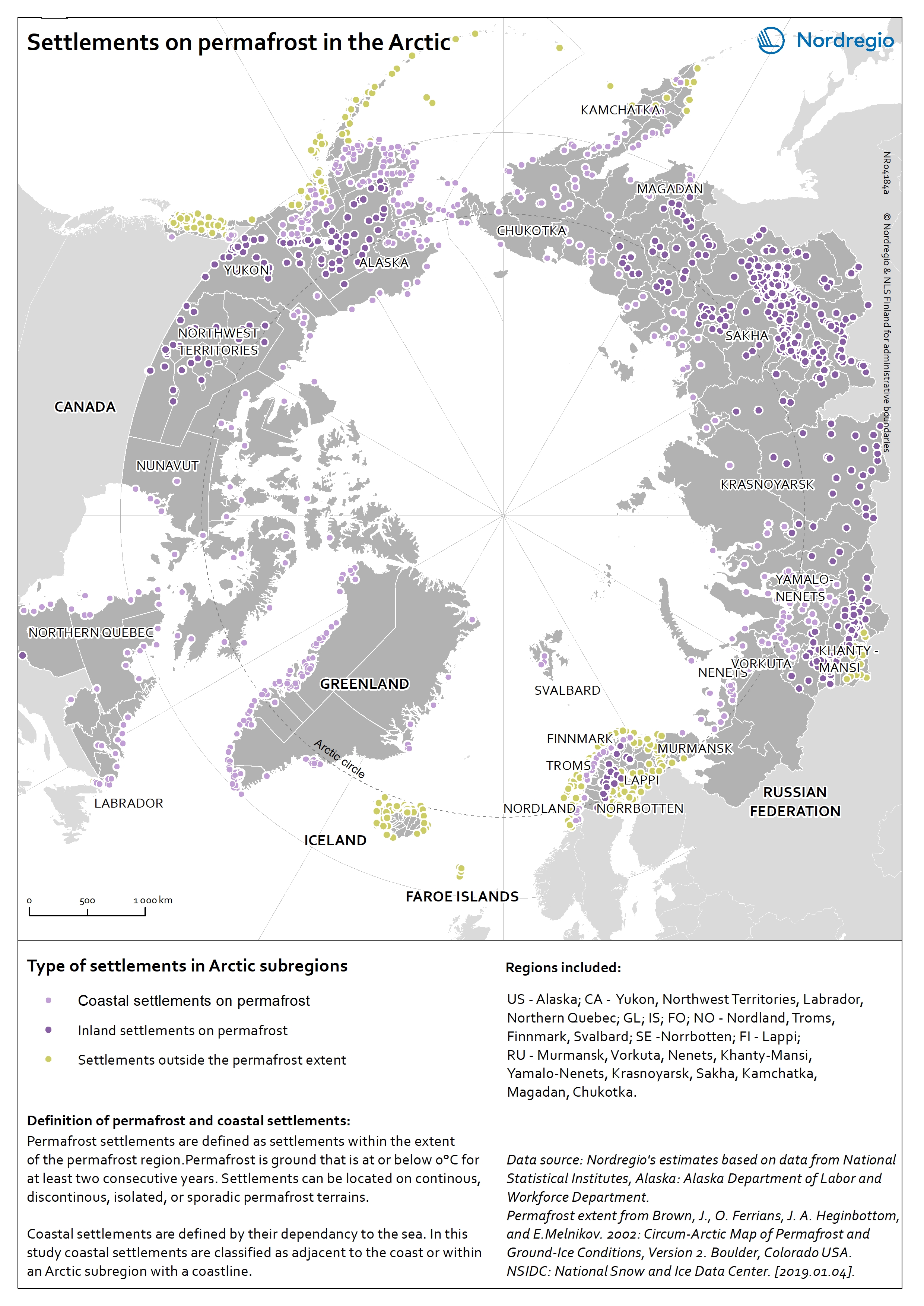
Settlements on permafrost in the Arctic
The map shows the distribution of coastal and inland settlements on permafrost in the Arctic in 2017. Permafrost is ground that is at or below 0°C for at least 2 consecutive years. The purple tones indicate settlements located on permafrost and distinguishes between coastal (light purple) and inland (dark purple) settlements. Settlements located outside the permafrost extent are in yellow. Among all Arctic settlements, 66,1% are located on permafrost. Settlements are classified as permafrost settlements if they are located within the permafrost extent, comprising zones of continuous, discontinuous, sporadic, or isolated permafrost. Among all permafrost settlements 46,0% are coastal. Coastal settlements are defined by their dependency to the sea. They are either adjacent to the coast, located inland along large rivers with a free connection to the open sea, or located within a short distance to the sea (0-200 km). In this map, coastal settlements comprise all settlements that are located within an Arctic subregion adjacent to the coast. Most of the settlements located outside the permafrost extent area are in the Nordic countries (Iceland, Norway, the Faroe Islands, Sweden, and Finland) as well as in the southern part of Alaska (USA) and the western part of the Russian Arctic. Almost all Arctic settlements in the Russian Federation and in Canada are located on permafrost. The increase in air surface temperature observed in the Arctic causes dramatic changes in the permafrost thermal regime leading to the destabilisation of infrastructure built on permafrost.
2019 March
- Arctic
- Demography
- Environment
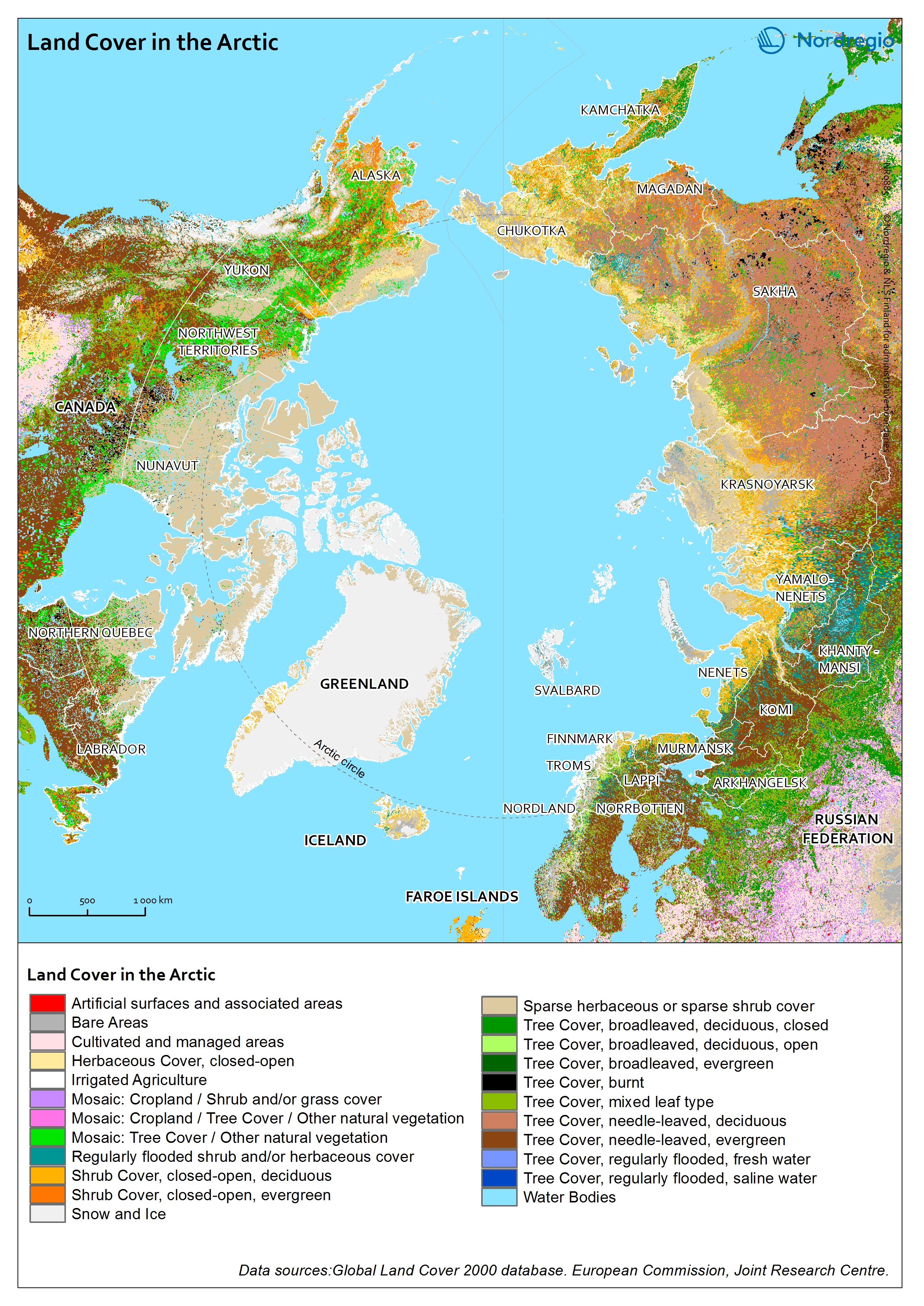
Land Cover in the Arctic
The terrestrial ecosystem of the Arctic is characterized by low tundra vegetation, composed of shrubs, herbaceous plants, mosses, and lichens. Arctic vegetation is becoming more productive due to increasing air temperature. One of the main trends shows an increase in tall shrub cover. On the contrary, the cover of lichen and moss has declined in response to regional warming.
2019 January
- Arctic
- Environment
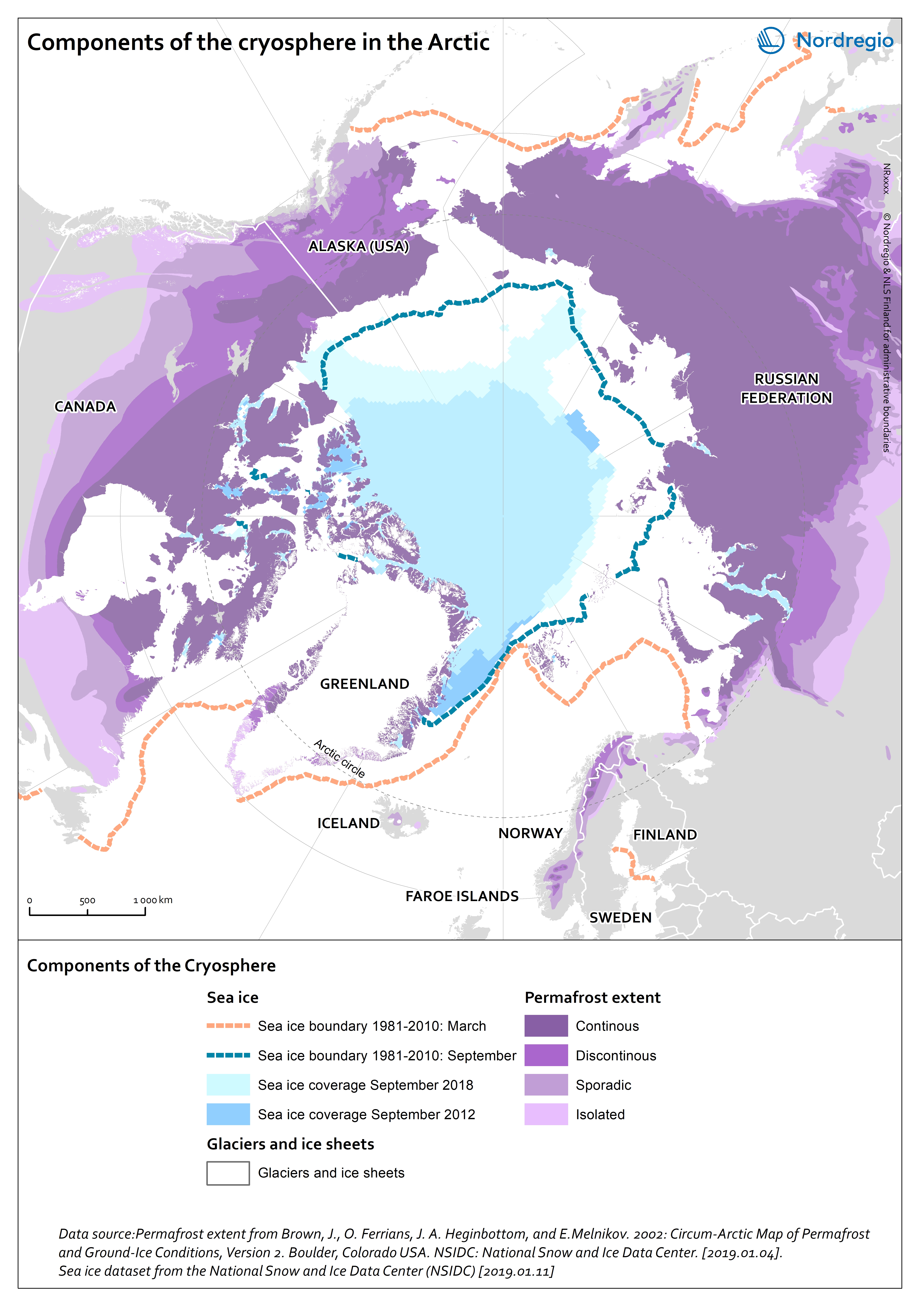
Components of the cryosphere in the Arctic
This map shows the main components of the cryosphere in the Arctic: sea-ice, permafrost, ice-sheets, and glaciers. Sea-ice covers most of the Arctic Ocean during winter. The sea-ice extent reaches its maximum in March, when it covers approximately 14-16 million km2. Since 1979, the Arctic ice extent in winter has decreased by 3% per decade relative to the 1981-2010 average, and this trend accelerates. Similarly, ice-sheets and glaciers, which cover globally over 15 million km2 are melting. In the Arctic, the main ice-sheet is the Greenlandic ice sheet. Most of the land surface in the Arctic is underlay by permafrost, ground that is at or below 0°C for at least 2 consecutive years. The purple tones on the map indicates the extent of the northern circumpolar permafrost. Permafrost can occur as continuous (dark purple, 90-100% coverage), discontinuous (purple, 50-90% coverage), sporadic (light purple, 10-50%), or isolated patches (magenta, 0-10% coverage). Permafrost is thawing due to increased air temperatures and precipitations in the Arctic. Permafrost temperature increased by 0.29 ± 0.12°C between 2007 and 2016.
2019 January
- Arctic
- Environment
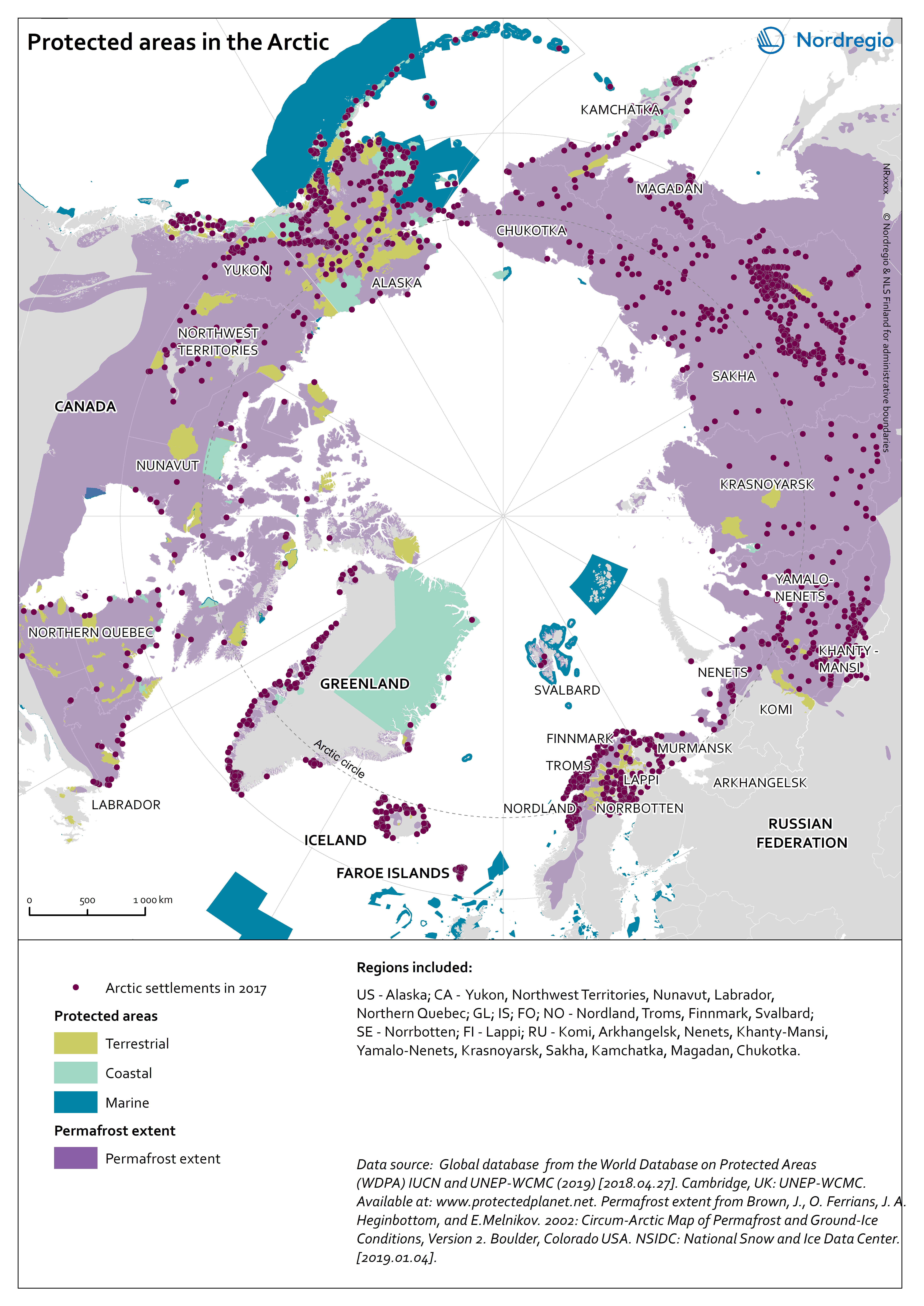
Protected areas in the Arctic
Within the northern circumpolar permafrost region, there are ca. 1300 protected areas. Most of these areas are terrestrial (1069), while 126 are coastal – defined as partially within the marine environment – and 62 are marine. The World Database on Protected Areas (WDPA)[1] includes a wide range of protected areas, including national protected areas recognized by the government, areas designated under regional and international conventions, privately protected areas and indigenous peoples’ and community conserved territories and areas. Greenland is one of the countries with the largest protected terrestrial area (41,0%). [1] IUCN and UNEP-WCMC (2019), The World Database on Protected Areas (WDPA) [On-line], [January 2019]. Cambridge, UK: UNEP-WCMC. Available at: www.protectedplanet.net.
2019 January
- Arctic
- Environment
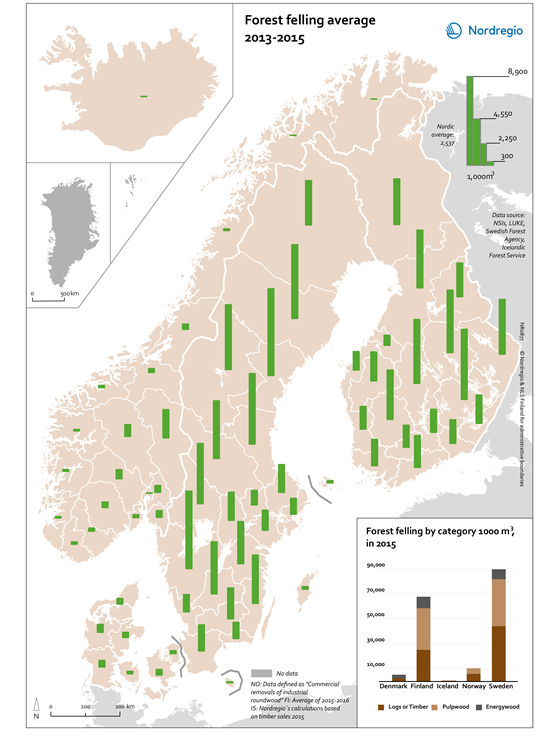
Forest felling average 2013-2015
This map shows the forest felling at the regional level in the Nordic Region (average 2013-2015). The chart shows the forest felling by category in 1,000 m3 at the national level in the Nordic Region in 2015. On the map, the green bars indicate the average 2013-2015 forest felling. The higher the bar, the greater the forest felling in the region. The grey colour indicates regions with no data. The chart shows different forest felling categories in 1,000 m3 in 2015. The dark brown represents logs or timber, the light brown represents pulpwood, and the dark grey the energywood. The Nordic Region has a large potential for forest multi-use. Sweden and Finland have the largest forest felling in 1,000 m3, with the greatest use in logs and timber. Wood bi-products is extensively used for energy purposes and the forests display a large potential for increasing the production of renewable energy as well as other bio-based products.
2018 February
- Environment
- Nordic Region
- Others

Biogas production
These maps show the energy produced by biogas (in GWh) as well as the number of facilities producing bioenergy in the Swedish regions. The maps also show the location and type of biogas plants in Denmark, Finland, and Iceland. The brown shading indicates the produced energy in GWh in each region. The darker the brown, the larger the energy produced. The black circles are proportional to the number of facilities producing bioenergy in the Swedish region. The location of biogas plants in Denmark, Finland, and Iceland is indicated by coloured circles. The colours indicate the type of biogas plant. Biogas production is widely distributed across the Nordic Region and between the types of sources used. In 2015, 18% of the energy use in Denmark came from biomass and waste. In the western part of Denmark, biogas is mainly based on manure from farms supplemented with sludge and organic waste from wastewater plants. The vast infrastructure for gas makes it easy and accessible for farmers to link biogas to the existing energy net. The largest numbers of plants in Finland are based on farms and landfills. In 2015 in Sweden, 282 facilities produced 1947 GWh biogas with the largest regional production being in Skåne (417.5 GWh), Västra Götaland (350.9), and Stockholm (255.8). Iceland had a biogas facility in Reykjavík at Álfsnes landfill with plans for expansion in 2018.
2018 February
- Environment
- Nordic Region

